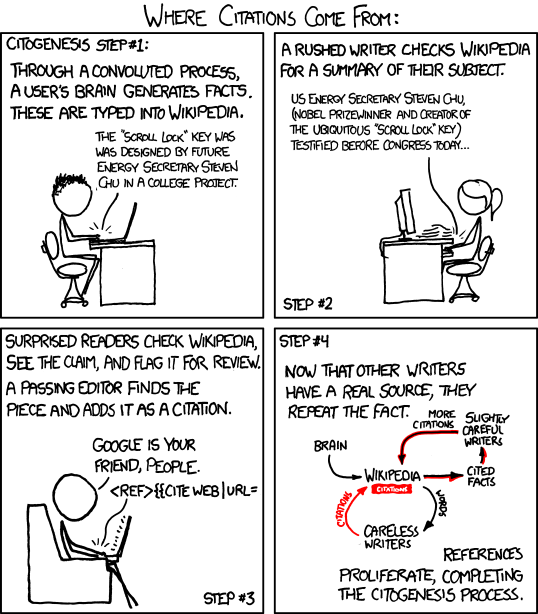Comic

xkcd 978 by Randall Munroe, CC BY-NC 2.5
Transcript
Where Citations Come From:
Citogenesis Step #1
Through a convoluted process, a user's brain generates facts. These are typed into Wikipedia.
[Hairy sits at a desk, typing on a laptop.]
Hairy: (typing) The "scroll lock" key was was designed by future Energy Secretary Steven Chu in a college project.
Step #2
A rushed writer checks Wikipedia for a summary of their subject.
[Ponytail sits at a desk, typing on a desktop.]
Ponytail: (typing) US Energy Secretary Steven Chu, (Nobel Prizewinner and creator of the ubiquitous "scroll lock" key) testified before Congress today...
Step #3
Surprised readers check Wikipedia, see the claim, and flag it for review. A passing editor finds the piece and adds it as a citation.
[Cueball sits on a couch with a laptop in his lap, typing.]
Cueball: Google is your friend, people. (typing) <ref>{{cite web|url=
Step #4
Now that other writers have a real source, they repeat the fact.
[A flow chart, with "Wikipedia citation" in the center. The word "Wikipedia" is in black, the word "citations" is white with a red background.
[A black arrow leads from "brain" to "Wikipedia."]
[A black arrow labeled "words" leads from "Wikipedia" to "careless writers," and a red arrow labeled "citations" leads back to "Wikipedia citations."]
[A black & red arrow leads from "Wikipedia" to "cited facts" which leads to "slightly more careful writers," which leads to "more citations," which leads back to :"Wikipedia" (all black & red arrows).]
References proliferate, completing the citogenesis process.
see also - circular reporting